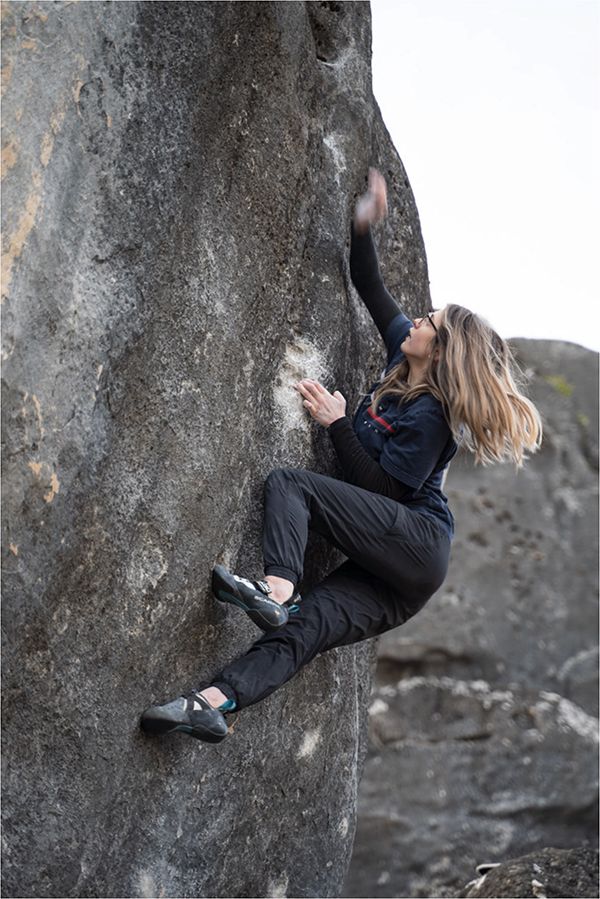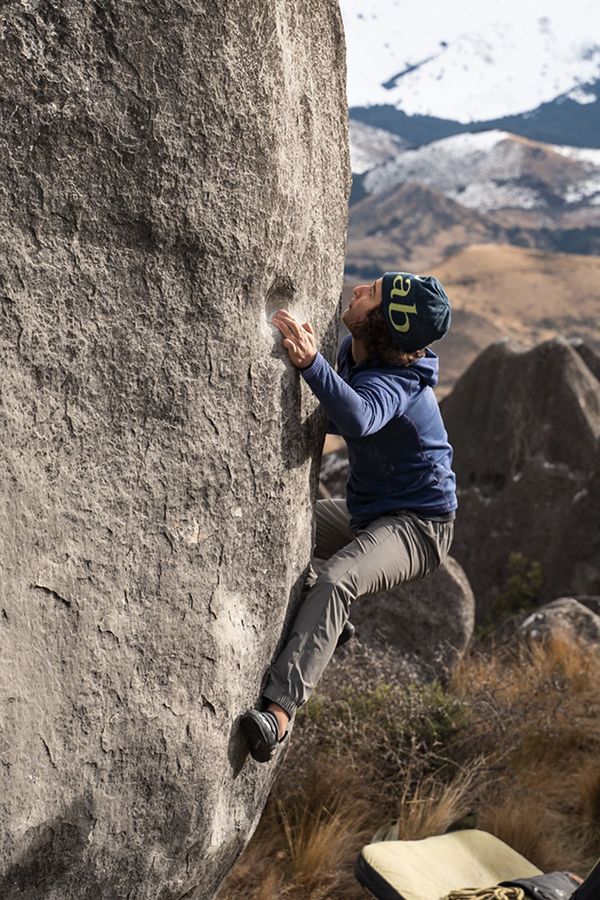
Ladies Crushing - Flock Hill, Matariki 2022
By Rachel Musgrave
Erin Stewart’s article in the New Zealand Alpine Journal (‘Mind the Gap’, Spring 2021) certainly got a few of us talking. She raised a number of questions about some possible reasons why there is a disparity between women and men climbing hard in Aotearoa. It is a complex issue and there are no simple answers.
The key question for me is why is it that to date, few women have progressed to push their limits outdoors by climbing hard boulders and sport climbs in Aotearoa? Especially when I observe so many women climbing very well indoors on pretty much a weekly basis. Is it a lack of female role models, lack of representation and the opportunities for females to climb outside as Erin has suggested?
It must be noted that until recently, I have almost exclusively climbed with men, merely because I didn’t have a choice … if I wanted to climb, it was with the boys or with no one. I have always valued my regular male climbing partners as trusted friends and (like Erin) I have always found them to be welcoming and supportive of my climbing endeavours. This isn’t about to change.
But climbing with women is different …
Erin, Christina Rivett, Erica Gatland and I are sometimes lucky enough to climb together at Flock Hill (and elsewhere). We often lament the fact that sheer representation from females climbing outdoors is not widespread in Aotearoa (compared to overseas) and what a shame that is. We agree that we really enjoy a 'female experience' at the crag and find it has a positive effect on us. Maybe we could (and should) make some effort to be role models and to try to encourage ongoing participation in the outdoor bouldering environment by females? So we thought it would be great to create a women’s bouldering group and organise a day, or days, where we invited some female climbers who were interested to come together at Flock Hill and climb.
And so the first ‘Ladies Crushing' event was born. We got really lucky and June 24th was a perfect day at Flock Hill. Cold, but not too cold and the boulders were dry. Conditions couldn’t really have been better.

Ten women crushers turned up, ranging in age and ability from teenage to veteran; beginner to expert … and everything in between. We didn’t really have a plan, but a simple plan evolved. We warmed up and began to explore and try some problems together. There’s something for everyone at Flock Hill, over 1000 boulder problems to date and counting.
A couple of my male friends were up at Flock Hill bouldering over Matariki as well, so I asked them for their opinion of our women's bouldering day. They commented that they liked the idea because they often feel pressure to make it fun for their female friends when they go climbing together. They sometimes feel like their own climbing goals dominate and overshadow those of the female climbers, and that they don’t know how to inspire and motivate without applying the kind of pressure that seems to have a negative effect.
At the end of the day, when the ladies were starting to wind down from a frenetic pace of activity and quite a bit of crushing, I asked them to comment. What had made them interested in participating in a women's bouldering day? What did they hope to get out of it? Any reflections on how the day had been for them?
Unanimously, all agreed that they had turned up because they had hoped to meet new people who shared a common interest, make friends and have a fun day out—all agreed that the day ticked all those boxes for them. At least 80% of success is turning up (statistics not verified by actual data), so thanks to all those who could make it to the first 'Ladies Crushing' day.

Cast & Crew:
Anna - liked learning new techniques like knee barring, mantles and laybacks. 'It was my first full day climbing outdoors.'
Erica - liked climbing with similar-sized people to share beta and enjoyed having all the pads and not having them taken away by the boys to try hard projects.
Mayaan - agreed with Erica and liked seeing really good climbers like Riley finesse their way up problems with technique.
Erin - agreed with Erica and Mayaan, 'Yeah, less biceps and brute strength, more finesse and technique.'
Rach - Was psyched to be there and see everybody crushing. No active-wear to be seen.
Kiri - was a competition climber who represented Aotearoa, but got burned out and had injury problems. She really enjoyed exploring the field and finding some climbing goals for herself.
Riley - also enjoyed exploring the field and being encouraged to try problems that she wouldn’t otherwise have known about or tried. 
Sooji - had forgotten how much fun bouldering is and how good it is just being at Flock Hill for the day.
Matilda - 'I tried lots of things but didn’t get up much. Just call me 'Matilda No Sends', ha ha. It was so much fun!'
Notable Mentions:
Sarah - had a six-month old baby in tow “I thought Flock Hill might be a bit of a logistical nightmare”. But flew all the way from Auckland to go bouldering and so went to Quantum Field instead to ease the logistics.
Christina - had the flu and was really disappointed to miss out, but deserves most of the credit for getting this thing off the ground. We know she will definitely be there crushing hard boulders next time.
***
We loved 'Ladies Crushing' so much, we are already organising the next one in September, so look out for the 'Basin Babes' Facebook page for details (by Erica).

So, back to the questions raised earlier. I agree with Erin, and believe that climbing role models you can personally relate to (ie. other women) can have an elevated effect on your psyche, motivation and self-belief. This was certainly a factor for me.
When I started climbing, there was not really a climbing gym culture to speak of. We didn’t train (except to do one arm lock-offs on edges). We just went climbing outdoors, figured it out by a process of trial and error—and by reading climbing magazines over and over. I was fascinated by the photos. Who was putting up the hardest routes in the world? In what style and with what ethics? What colour lycra did they wear? It was all preserved in hard copy. Instagram and YouTube didn’t exist then. You couldn’t watch the world’s best women climbers and find out about their achievements in real time.
I had been climbing for less than a year when I travelled to the south of France on an extended sport climbing trip. On any given day, at any given crag, I had the opportunity to watch the current global female sport climbing elite in the flesh - Lynn Hill, Nanette Raybaud, Isabelle Patissier and Robyn Erbesfield to name a few. They were my heroines and yet there I was hanging out and climbing in close proximity to them.
I watched them, absorbing everything I could about what routes they were trying, their climbing style, how they solved problems, their behaviour. And much to my embarrassment, they would sometimes watch me climb, occasionally shouting one word of encouragement, 'Allez!'. Lynn Hill once belayed me and gave me some tips on my project, despite it being her warm up and several grades easier than the route she was trying. I found out later that if she had climbed her project on that day, it would have been the hardest redpoint ascent by a female in the world.
I quickly realised that compared to them, my climbing achievements were inconsequential—they were the best in the world, I was pretty much a beginner—nobody cared except me, so I should just try hard and love doing it. That climbing trip had a profound effect because I realised what was possible as a female climber if you back yourself, but I also saw first hand that the best climbers in the world value effort, psyche and respect—not necessarily whether you are (or aren't) a very good climber.
Soon after returning to Aotearoa, I saw a photo of Megan Turnbull climbing El Topo (28) at Whanganui Bay in the The Climber magazine. It was the hardest ascent by a woman in Aotearoa to date. I was super inspired by that and it got me thinking … maybe I could climb a 28? I started to get semi serious about climbing and gave up other things in my life so I could make time to do it. At the same time, Mayan Smith-Gobat came on the scene.
Mayan was an exceptional climber who proved that a woman from Aotearoa could make it on the world stage for rock climbing. Yes—we were competitive with each other, but I always found that to be a positive driver, not a barrier to my own personal performance. Having Mayan around at the same time motivated me to climb, train, find projects … do everything harder. I really enjoyed following her successes and seeing her around at the crags to share stories and support each other to keep trying and pushing ourselves. It was pretty humbling to watch Mayan warm up most days on my grade 29 project at the Cave, but watching her taught me so much about the route and how to climb it. Mayan was super psyched for me when she was there to see me finally redpoint one of my hardest projects.
Remember ladies, if you want to crush hard outdoors, first you have to get amongst it. Get out and find some hard projects for yourselves. Look for routes or boulder problems that really inspire you—it can’t just be about the grade, you have to want it! Then get yourselves both mentally and physically prepared to have a go … it will probably involve some hard work … remember that your project may well be someone else's warm up. Get over it, watch and learn! Oh … and make sure you have a good team of pro-caddies on board who support you (and who you support) to reach your respective climbing goals.
Nowadays, from what I have seen, there is a wealth of talent, ability and the determination to succeed amongst female climbers being fostered in climbing gyms. I am confident that the next generation of really hard female boulderers and climbers are just waiting in the wings and that they will push the standards outdoors far beyond what has already been achieved in Aotearoa. Some of you are already leading the way and that is rad.